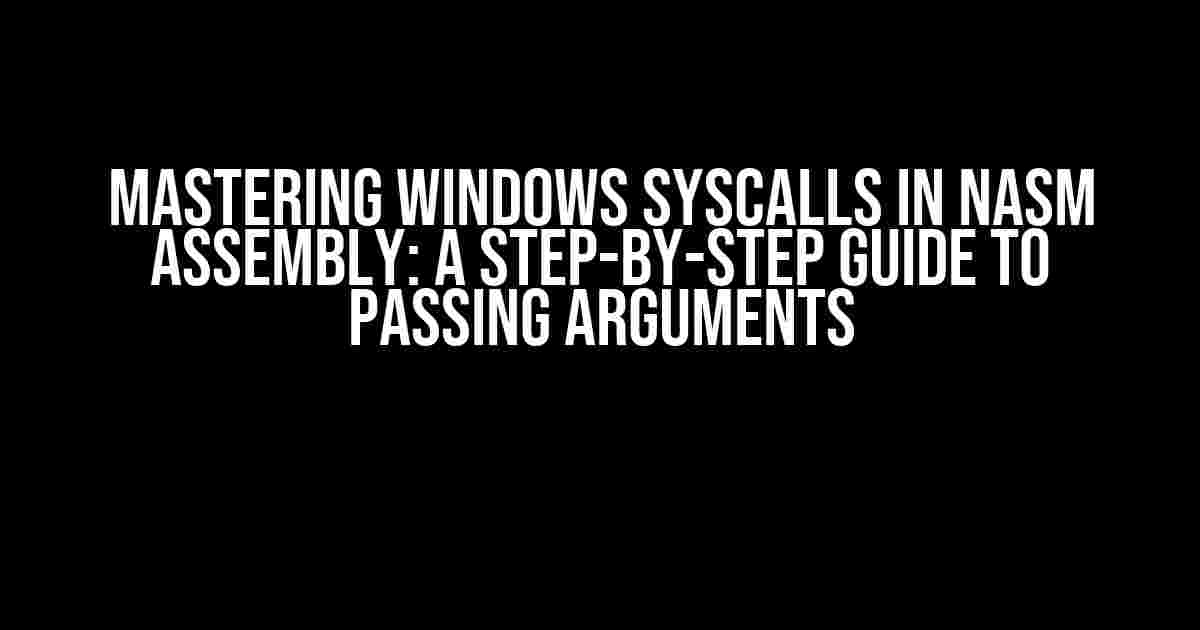Welcome, fellow assembly language enthusiasts! Today, we’re going to dive into the world of Windows syscalls and explore the oft-misunderstood realm of passing arguments to these system calls using NASM assembly. By the end of this article, you’ll be well-equipped to tackle even the most complex syscall scenarios with confidence.
What are Windows Syscalls, and Why Do We Need to Pass Arguments?
A syscall, short for system call, is a request to the operating system to perform a specific task or function. In Windows, syscalls are the primary way for user-mode applications to interact with the kernel-mode operating system. When we make a syscall, we’re essentially asking the OS to do something on our behalf, such as reading from a file, creating a process, or allocating memory.
Passing arguments to syscalls is crucial because it allows us to customize the behavior of the system call and provide it with the necessary information to perform the desired task. For example, when making a syscall to read from a file, we need to pass the file handle, the buffer to store the read data, and the number of bytes to read as arguments.
The Anatomy of a Windows Syscall in NASM Assembly
In NASM assembly, a Windows syscall typically takes the following form:
mov eax, syscall_number
mov ebx, argument1
mov ecx, argument2
int 0x80
In this example, we:
- Load the syscall number into the EAX register.
- Load the first argument into the EBX register.
- Load the second argument into the ECX register.
- Trigger the syscall using the INT 0x80 instruction.
Passing Arguments to Windows Syscalls
Now that we’ve covered the basics, let’s explore how to pass arguments to Windows syscalls in NASM assembly. We’ll focus on the most common types of arguments: integers, pointers, and structures.
Integer Arguments
Integer arguments are straightforward – we simply load the value into the corresponding register. For example, let’s say we want to make a syscall to create a new process using the CreateProcess function, which takes an integer argument specifying the creation flags:
mov eax, 0x18 ; CreateProcess syscall number
mov ebx, 0x04 ; CREATE_NEW_CONSOLE creation flag
int 0x80
In this example, we load the creation flag value (0x04) into the EBX register before making the syscall.
Pointer Arguments
Pointer arguments require a bit more care. We need to load the address of the pointer into the corresponding register. Let’s consider an example where we want to read from a file using the ReadFile function, which takes a pointer to a buffer as an argument:
section .data
buffer times 1024 db 0
section .text
mov eax, 0x3F ; ReadFile syscall number
mov ebx, [file_handle] ; file handle
mov ecx, buffer ; buffer address
mov edx, 1024 ; number of bytes to read
int 0x80
In this example, we load the address of the buffer into the ECX register using the buffer label. Note that we use square brackets [] to indicate that we want to load the address, not the value stored at that address.
Structure Arguments
Structures are a bit more complex, but fear not! We can pass structure arguments to syscalls by loading the address of the structure into the corresponding register. Let’s say we want to make a syscall to create a new window using the CreateWindowEx function, which takes a pointer to a WNDCLASS structure as an argument:
section .data
wndclass:
wc_style db 0
wc_glbclass db 0
wc_wndproc dd 0
wc_cbClsExtra dd 0
wc_cbWndExtra dd 0
wc_hInstance dd 0
wc_hIcon dd 0
wc_hCursor dd 0
wc_hbrBackground dd 0
wc_lpszMenuName dd 0
wc_lpszClassName dd 0
section .text
mov eax, 0x28 ; CreateWindowEx syscall number
mov ebx, wndclass ; address of WNDCLASS structure
int 0x80
In this example, we load the address of the wndclass structure into the EBX register. Note that we need to define the structure layout in the .data section and load the address of the structure into the register.
Additional Considerations
When passing arguments to Windows syscalls, keep the following tips in mind:
- Argument order matters!** Be sure to consult the documentation for the specific syscall you’re using to ensure you’re passing arguments in the correct order.
- Register usage**: Be mindful of which registers you’re using to pass arguments. Some syscalls may require specific registers, while others may allow you to use any register.
- Structure alignment**: When passing structures as arguments, ensure that the structure is properly aligned in memory. Windows requires structures to be aligned on 4-byte or 8-byte boundaries, depending on the architecture.
- Pointer arithmetic**: When passing pointers as arguments, be careful with pointer arithmetic. Make sure you’re loading the correct address into the register, and consider using labels or symbolic constants to make your code more readable.
Conclusion
Mastering the art of passing arguments to Windows syscalls in NASM assembly requires practice, patience, and attention to detail. By following the guidelines and examples outlined in this article, you’ll be well-equipped to tackle even the most complex syscall scenarios. Remember to consult the documentation for each syscall, and don’t hesitate to experiment and learn from your mistakes.
Additional Resources
If you’re new to Windows syscalls or NASM assembly, here are some additional resources to help you deepen your knowledge:
- Microsoft Documentation: Windows System Calls
- NASM Documentation
- MASM32 Forum (for 32-bit assembly programming)
Happy coding, and don’t hesitate to reach out if you have any questions or need further clarification on any of the topics covered in this article!
| Syscall Number | Syscall Name | Arguments |
|---|---|---|
| 0x18 | CreateProcess | CREATE_NEW_CONSOLE, command_line, application_name, process_attributes, thread_attributes |
| 0x3F | ReadFile | file_handle, buffer, number_of_bytes_to_read |
| 0x28 | CreateWindowEx | WNDCLASS structure, window_title, window_style, x, y, width, height, parent_window, hInstance |
This table provides a brief overview of the syscalls mentioned in this article, along with their corresponding arguments. Consult the Microsoft documentation for a comprehensive list of Windows syscalls and their parameters.
Frequently Asked Question
Get ready to dive into the world of Windows system calls in NASM assembly!
What is the general syntax to pass arguments to a Windows syscall in NASM assembly?
The general syntax to pass arguments to a Windows syscall in NASM assembly is to push the arguments onto the stack in reverse order, followed by the syscall number in the EAX register, and finally, invoke the syscall using the `syscall` instruction. For example, to call the `CreateFile` syscall, you would push the file name, creation disposition, and other parameters onto the stack, followed by the syscall number (0x5B for `CreateFile`), and then invoke the syscall using `syscall`.
How do I pass string arguments to a Windows syscall in NASM assembly?
To pass string arguments to a Windows syscall in NASM assembly, you need to push the address of the string onto the stack, not the string itself. You can use the `lea` instruction to load the effective address of the string into a register, and then push the register onto the stack. For example, if you have a string `file_name db ‘example.txt’, 0` and you want to pass it as an argument to the `CreateFile` syscall, you would use `lea rsi, [file_name]` to load the address of the string into RSI, and then push RSI onto the stack.
What is the correct order to push arguments onto the stack for a Windows syscall in NASM assembly?
The correct order to push arguments onto the stack for a Windows syscall in NASM assembly is to push them in reverse order, from right to left. This is because the Windows syscall convention uses the `stdcall` calling convention, which passes arguments on the stack in reverse order. For example, if a syscall takes three arguments `arg1`, `arg2`, and `arg3`, you would push them onto the stack in the order `arg3`, `arg2`, `arg1`.
How do I handle 64-bit arguments when passing them to a Windows syscall in NASM assembly?
When passing 64-bit arguments to a Windows syscall in NASM assembly, you need to push the high 32 bits and low 32 bits of the argument separately onto the stack. You can use the `mov` instruction to load the 64-bit value into a register pair (e.g., RDX:RAX), and then push the high and low parts of the register pair onto the stack separately.
What is the purpose of the `syscall` instruction when passing arguments to a Windows syscall in NASM assembly?
The `syscall` instruction is used to invoke the Windows syscall after pushing the arguments onto the stack. It generates a syscall trap that causes the CPU to switch to kernel mode and invoke the Windows syscall dispatcher, which then calls the specified syscall with the passed arguments.


